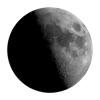James Webb Space Telescope
James Webb Space Telescope is in the constellation of Scorpius, at a distance of
Finder Charts
The sky charts below show, at different resolutions, the position of James Webb Space Telescope in the sky. Click on each chart to access the interactive star map tool.
The following map uses photographic imagery from the Digitized Sky Survey (DSS) to realistically visualize the precise position of James Webb Space Telescope against the stars in the background. The horizontal size of the map measures 60 arcminutes. Click on the image to access a more detailed full-screen view.


Equatorial Coordinates
Apparent
J2000
Additional Information
Rise and Set Times
The following table lists today's rise, transit and set times of James Webb Space Telescope from Greenwich, UK (all times relative to the local timezone Europe/London):
If you need to access this information frequently for your observations, you can create a simple customized Quick Access page, so that you can easily bookmark it in your browser favorites or add a shortcut to your mobile phones' home screen.
Distance from Earth
The distance of James Webb Space Telescope from Earth is currently
The following graph shows the distance of James Webb Space Telescope from Earth as a function of time. In the chart the distance is measured in Astronomical Units and the data is sampled with an interval of 1 day.
Note: The values in this chart may not be entirely accurate around the time of closest approach for objects passing very close to Earth at high speed (e.g., Near-Earth Objects).
The value of the distance of James Webb Space Telescope from Earth is also available as a real time updated value in the live position tracker.
Closest Approach to Earth
In the period between December 26, 2021 and October 27, 2029, the closest approach of James Webb Space Telescope to Earth happened on Sunday 26 December 2021 at a distance of 0.000894 Astronomical Units, or 133,698 kilometers:
Note: the values for the closest approach are computed with a sampling interval of 1 day.
Orbit Visualization
The following chart is a 3D animated visualization of the orbit of James Webb Space Telescope relative to the other major objects in the Solar System.
15 Days Ephemeris
The following table lists the ephemerides of James Webb Space Telescope computed for the past and next 7 days, with a 24 hours interval. Apparent celestial coordinates are provided.
| Date | Right AscensionR.A. | DeclinationDec. | MagnitudeMag | Constellation |
|---|---|---|---|---|
| Jun 24 2025 | 17h 52m 05s | -36° 24’ 53” | N.A. | Scorpius |
| Jun 25 2025 | 17h 52m 21s | -36° 23’ 55” | N.A. | Scorpius |
| Jun 26 2025 | 17h 52m 37s | -36° 22’ 18” | N.A. | Scorpius |
| Jun 27 2025 | 17h 52m 56s | -36° 20’ 00” | N.A. | Scorpius |
| Jun 28 2025 | 17h 53m 18s | -36° 17’ 03” | N.A. | Scorpius |
| Jun 29 2025 | 17h 53m 43s | -36° 13’ 26” | N.A. | Scorpius |
| Jun 30 2025 | 17h 54m 13s | -36° 09’ 12” | N.A. | Scorpius |
| Jul 01 2025 | 17h 54m 46s | -36° 04’ 21” | N.A. | Scorpius |
| Jul 02 2025 | 17h 55m 25s | -35° 58’ 55” | N.A. | Scorpius |
| Jul 03 2025 | 17h 56m 07s | -35° 52’ 53” | N.A. | Scorpius |
| Jul 04 2025 | 17h 56m 55s | -35° 46’ 18” | N.A. | Scorpius |
| Jul 05 2025 | 17h 57m 48s | -35° 39’ 09” | N.A. | Scorpius |
| Jul 06 2025 | 17h 58m 45s | -35° 31’ 28” | N.A. | Scorpius |
| Jul 07 2025 | 17h 59m 46s | -35° 23’ 15” | N.A. | Scorpius |
Additional Resources on TheSkyLive
- James Webb Space Telescope: Complete reference information on TheSkyLive.com.
- Where is James Webb Space Telescope?: Key information on where to find James Webb Space Telescope in the sky.
- Distance of James Webb Space Telescope from Earth: Find out how far James Webb Space Telescope is from Earth right now.
- Rise and Set Times: Rise and set times of James Webb Space Telescope from your location.
- Interactive Sky Map: Planetarium-style interactive visualization of James Webb Space Telescope's position in the sky.
- Live Position Tracker: High precision real time tracker of James Webb Space Telescope's position using deep space imagery.
- Ephemeris: 15 days James Webb Space Telescope's computed ephemeris.
- Orbit Visualization: 3D interactive visualization showing the orbit of James Webb Space Telescope with respect to the major Solar System objects.










